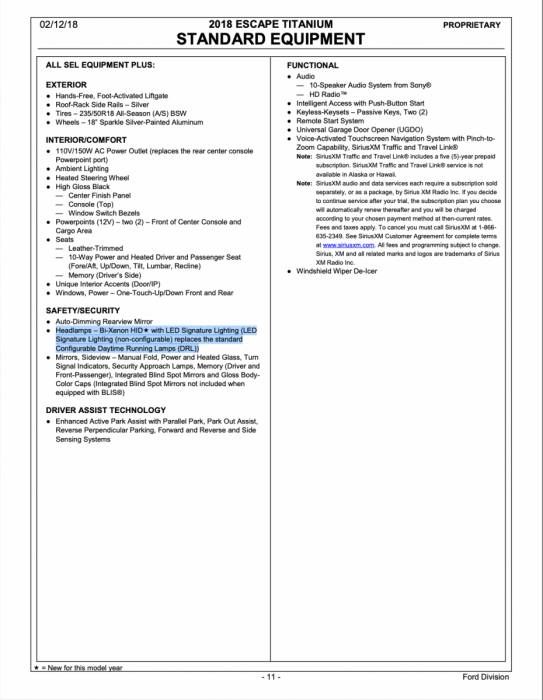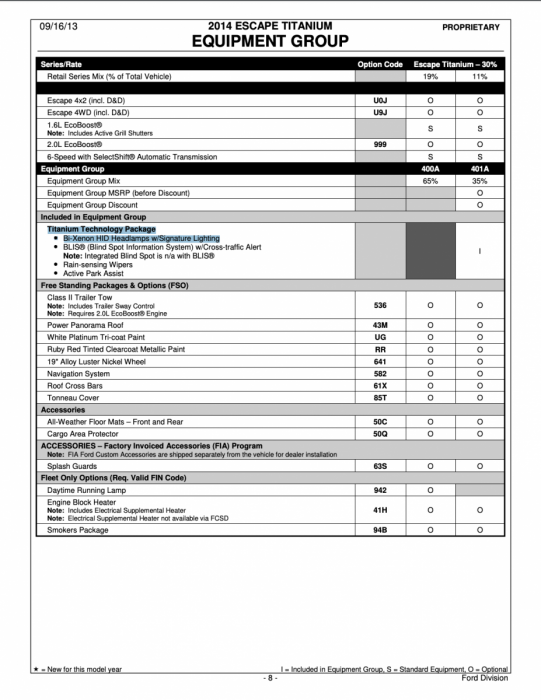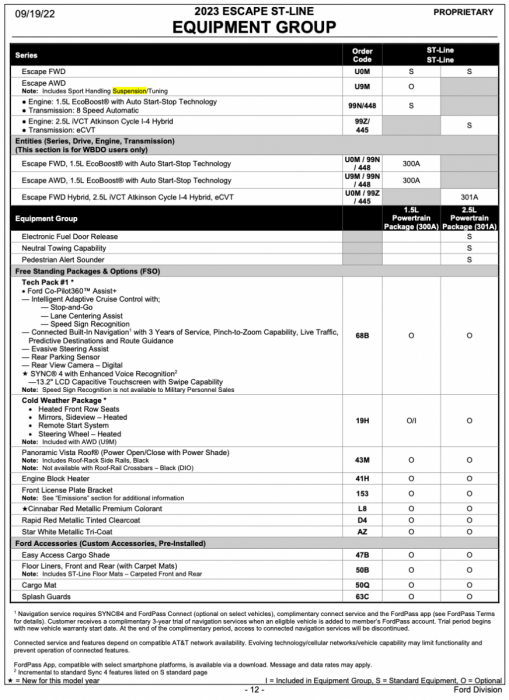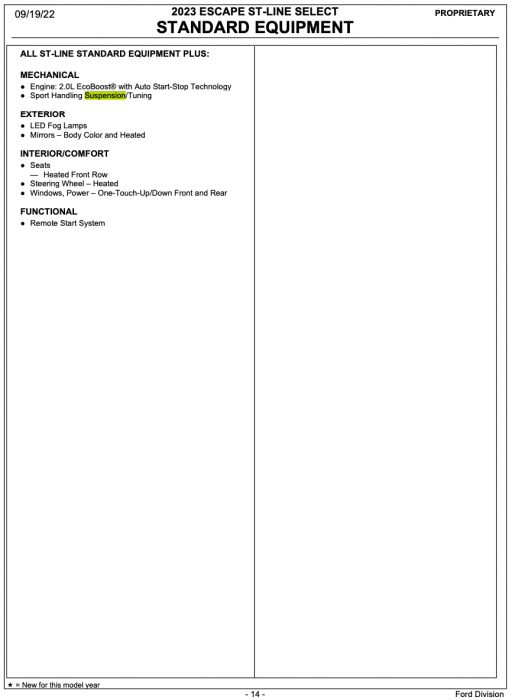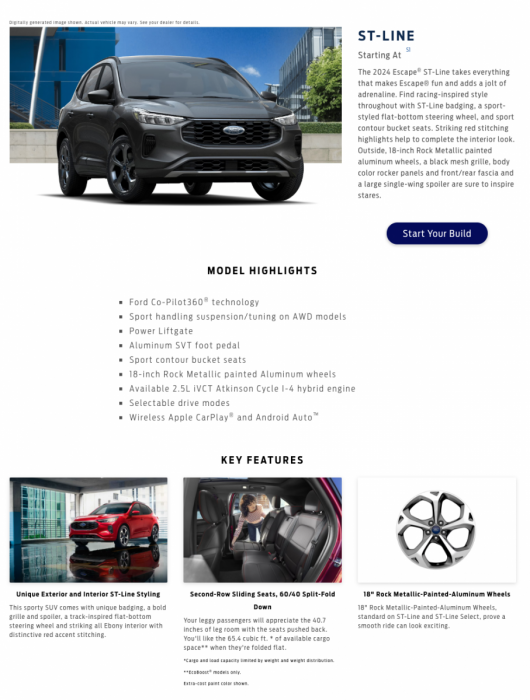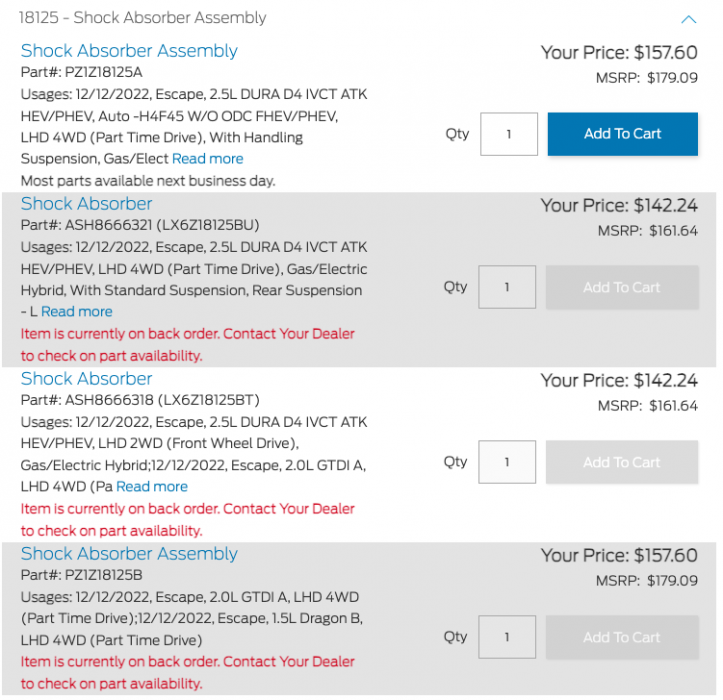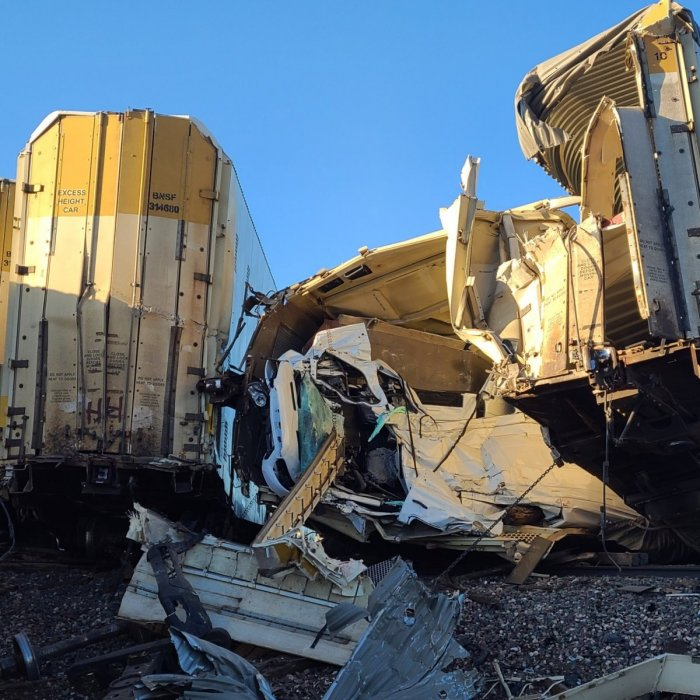

j2sys
Member-
Posts
325 -
Joined
-
Last visited
-
Days Won
2
Content Type
Profiles
Forums
Gallery
Downloads
Store
Everything posted by j2sys
-

Changing xenon low beam bulb - 2014 Escape Titanium
j2sys replied to akirby's topic in Escape & Kuga Forum
For 2018, S, SE, and SEL had halogen headlamps. Only Titanium had the Bi-Xenon HID headlamps (standard on Ti). For 2014 like @akirby was dealing with, they were even more rare - part of an optional Titanium Technology Package (401A). -

Ford Bronco Now Eligible For X-Plan Pricing
j2sys replied to ice-capades's topic in Ford Motor Company Discussion Forum
June 1, 2022. 1.5 years ago. https://fordauthority.com/2022/05/ford-shareholder-vehicle-discount-program-to-end-in-june/ -
What's the problem? If you can't charge it, then you'll just use more gas, like a regular, non-plug-in hybrid. You'd need a generator or a home energy storage battery system (e.g. Tesla Powerwall), not a UPS, to be able to charge the hybrid battery. Unless you're already investing in that system and have excess capacity to charge an Escape PHEV, you have a gas tank and an ICE, use them. Let the hybrid be its own generator.
-
As noted above, 2024 Maverick Plan pricing isn't posted online yet. Simple enough to calculate it yourself, though.
-
It's definitely possible to find a dealer that is willing to take X-Plan on a Maverick. Chances are much higher if you put in an order and wait for it to be built vs. buying off the lot, if you can even find one; even then there's no guarantee. Since you're looking for a hybrid, chances are incredibly slim at finding one on the lot in the first place. You may need to ask around to find a dealer willing to do so. To acquire a PIN, you need to either personally know a Ford corporate employee, work for an eligible Ford partner, or be a member of a qualifying group. Mustang Club of America is a group you can buy a membership for, which many have used as a way to "buy" access to X-Plan; this is not, however, an endorsement as I have no personal experience. Note that (at least officially), you must be a member for at least 90 days prior to your vehicle purchase. X-Plan pricing isn't currently listed online. You can calculate the approximate X-Plan price for yourself, however. Keep in mind that it caps the doc fee at the lesser of $100 or whatever your state law permits (though some dealers will refuse to honor this, in violation of their contractual agreement with Ford). See here for the price list: https://www.mavericktruckclub.com/forum/threads/2024-maverick-price-list-msrp-invoice-pricing-all-models-options.34193/ Formula: https://www.fordpartner.com/partnerweb/jsp/howitworks/fordpartner_rules.htm
-
Order guide specifically calls out "Sport Handling Suspension/Tuning" on ST-Line (AWD), ST-Line Select, ST-Line Elite. Basically, if you have one of the ST-Line trims, and AWD, you have this suspension. The only reason why it's called out any differently on the base ST-Line (no added word) trim is because the ST-Line 1.5L EcoBoost offers FWD and ST-Line Hybrid is FWD only. Select and Elite are 2.0L EB AWD or Hybrid AWD only. Base, Active, Platinum, PHEV do not list the suspension upgrades. Per parts.ford.com, the shocks appear different - note "with handling suspension" vs. "with standard suspension". Not sure what else is different.
-
Keep in mind that it was only with 2020 Escape that Ford switched over to superior liquid cooling for FHEV and PHEV HVBs, C-Max Hybrid and Energi used forced air cooling. Thus, some of the thermal characteristics in terms of warm-up and cool-down timing will have naturally changed.
-
Cost, of course. Same reason that the factory uses an even smaller battery than the 99RT4 specced in the manual. Also, 2020 Escape manual listed 99RT4 for hybrid, then 2021 listed 48H6 AGM, only to see 2022+ reverted to 99RT4. Even though, best I can tell, they never installed the larger AGM battery at the factory. Of course, even pointing this out to the dealer won't get them to push Ford to cover the 48H6 AGM as a replacement when the factory battery inevitably shows its flaws... Maybe if you have a 2021. Do bear in mind that, as noted, the 12V battery is not a starter battery. It powers the low voltage electronics, including closing the contactors on the HVB. The HVB starts the ICE by spinning up the eCVT. So Ford's excuse is that hybrids don't need much of a battery, except that neglects all the electronics that run on these modern vehicles, including long after they're turned off, continuing to drain the battery. On the other hand, an Escape EcoBoost's engine start/stop feature does use the 12V battery as a starter battery and needs to be able to power the electronics with the engine off - it has no possible charge source other than to fire the ICE back up. Even then, at least with Maverick EB, they've used both AGM and FLA batteries interchangeably for no apparent rhyme or reason except perhaps supply chain issues.
-
The hybrid's high voltage battery (HVB/traction battery) is charged through regen braking and by siphoning off power from the engine. The conventional 12V battery is not charged via a traditional alternator off the engine. Instead, it's charged off the HVB via the DC-DC converter. So long as the vehicle is running (even with the engine off), it will recharge the 12V battery. In other words, there's no reason to force the engine on. The problem is that the 12V battery is small and slow to charge, and various systems that keep running after the vehicle is turned off (including the FordPass modem) drain it quickly. Every time you go out to the vehicle when it's parked to load/retrieve something, it drains the battery. The longer you leave the infotainment system running before you turn the vehicle on or after you turn it off, the more it drains the battery. And this battery doesn't have much margin to give. In time, you notice that the infotainment system turns off much more quickly after you turn off the vehicle. The interior/exterior lights don't stay on as long. The passenger side intelligent access door handle does not respond when you grab it to unlock. The interior lights don't turn on when you open the door. All of these are signs that the BMS - Battery Management System - is kicking in its protections to keep you from draining the 12V battery where the vehicle won't start next time you need it. These are all symptoms of the tiny battery -- plus some of them may well have defective cells and actually have even less capacity than designed. As you've found, other Escape owners have ditched the factory battery for a larger 48H6 battery, switching from a conventional flooded lead acid to an AGM type. The bigger battery has more capacity, more margin, and AGM is said to charge more quickly. On Escape, it should be a drop-in replacement as there's plenty of room back there.
-
Maverick was always intended to have Hybrid as the base option that they could use to sell more hybrids as compliance cars, while leaving the 2.0L EB as the more powerful upgrade option that unlocks AWD, 4k tow, Tremor, etc. Lure you in with the hybrid's low starting price ("under $20k") and efficiency (40 mpg city), upsell you to the 250 HP etc. that you get with the 2.0L EB. Adding the 1.5L EB to the mix, which would've undercut the hybrid option, did not align with those plans. Plus, as the lower cost option, it would've probably been priced below hybrid. As it was, they were really pushing just to get themselves to sell a few XL Hybrids at "under $20k" AKA $21,495 with destination. For comparison, on a 2022 Escape, it was about $1800 more to go from 1.5L EB to hybrid. 2.0L EB was another ~$710. With destination and a similar up-charge from 1.5L EB to hybrid would've put the cheapest Maverick XL under $20k with destination. Now, they realize that the hybrids are selling themselves and they could've asked for more, so they flipped that by making 2.0L EB standard for 2024 Maverick, and an up-charge for hybrid. Raising prices to lower demand as they don't seem to anticipate building many more hybrids. That said, at this point, one might think they'd almost rather drop hybrid entirely and replace it with the fire breathing Dragon engine, at least on Maverick, since the EV sales negate the need for Maverick/Escape hybrids as compliance cars...
-
"Horrendous" is quite the over exaggeration if you've ever compared it against Ford's base audio system in these vehicles..
-

Ford Recalls 125K Mav, Escape, Corsair Hybrids
j2sys replied to ANTAUS's topic in Ford Motor Company Discussion Forum
Yes, and I was mentioning that I was looking forward to having a reliable, durable powertrain having dealt with too many of Ford's questionable transmissions, not expecting to have concerns with an engine that has shown to be reliable as well. -

Ford Recalls 125K Mav, Escape, Corsair Hybrids
j2sys replied to ANTAUS's topic in Ford Motor Company Discussion Forum
That would work out better for Maverick owners than Escape owners, since Mavericks are still inflated well above MSRP. To get a comparable 2023 Escape Hybrid to my 2022, at the same AZ price level I used previously, it would be a much greater than $3,000 difference, before factoring in the higher financing rates (unless Ford Credit did a collateral swap). That said, for the right numbers, I would not say no to that... -

Ford Recalls 125K Mav, Escape, Corsair Hybrids
j2sys replied to ANTAUS's topic in Ford Motor Company Discussion Forum
We're talking about the 2.5L Duratec 25 Atkinson Cycle engine used in Escape/Corsair/Maverick FHEV/PHEV, which Ford acknowledges had "isolated engine manufacturing issues" that could lead to block breach/engine failure and fire. Despite previously isolating a small batch of ~200 2021 Escape Hybrid units that might've had improperly machined crankshafts, and issuing recall 22S10 to inspect and replace as needed, Ford seems to be acknowledging that there have been ongoing quality issues building this engine at ChEP1 since it was launched in 2019. They did complete some "robustness actions" by September 1, 2022, which they believe addressed the engine failure risks, but still recalled all production through 3 dates in May 2023. This engine is paired with 2 variants of the HF45 eCVT, which, like the present Duratec 25 engine, has a long history of being a highly reliable product in its previous iterations. At least until they forgot how to build a crankshaft to spec... -

Ford Recalls 125K Mav, Escape, Corsair Hybrids
j2sys replied to ANTAUS's topic in Ford Motor Company Discussion Forum
Was finally looking for a known durable, reliable transmission after my DCT and AX4N/4F50B experiences. Was not expecting Ford to have potentially widespread "isolated engine manufacturing issues" for years that they would take years to acknowledge and try to find their way out of actually inspecting/replacing if necessary... Here's hoping that it's not as bad as they're making it sound when read between the lines. -

Ford Recalls 125K Mav, Escape, Corsair Hybrids
j2sys replied to ANTAUS's topic in Ford Motor Company Discussion Forum
Sure seems like they're either unsure what the exact problem is, or, more likely, what they are willing to do about it. 22S47 attempted to address "fluid dynamics" to decrease the risk that engine failure would lead to engine fire. All they did was take away some of our AGS vanes and punch a few holes in the bottom for ventilation, which Ford acknowledges in the docs linked above, didn't really do anything. Who would've thought? It's about as effective as trying to address engine failure with software. Turns out, vehicles that had these "modifications" performed - whether via recall or as a running change at the factory - still catch fire when the engine fails. They seem to be looking for an alternative to inspecting and potentially replacing up to in excess of 100,000 long blocks (which could easily exceed $100,000,000 if enough need replacement). At the same time, they're basically telling drivers that there's an unnecessarily high risk of failure/fire due to "isolated engine manufacturing issues". They also go on to acknowledge that they were having issues building the engines to an acceptable quality level, particularly focused around the crankshafts. Apparently building crankshafts is new for Ford... They seem fairly confident that after they finally completed their "robustness actions" on/before September 1, 2022, the risk of engine failure is significantly reduced - so far, they haven't had any reports of engine failure from engines built after this date, but it has only been ~9 months. Any units that have been built before the 3 listed dates in May are supposed to be on hold indefinitely. With Ford, we should really assume they mean there won't be any additional info until end of Q4, meaning by the end of the year. Then, they need to actually get any necessary parts available to dealers and we'll need to get appointments to bring in the affected vehicles for whatever the "remedy" is this time. Just hope it's better than making a few holes to improve "fluid dynamics" like they tried to use to get out of properly addressing the units with "isolated engine manufacturing issues". That said, several over on MTC have reported that there newer 2023s don't yet list the recall at https://www.ford.com/support/recalls/ so as far as the dealer is concerned, it's not actually been recalled (yet). Thus, they've been able to take delivery. Speaking of those taking delivery in recent weeks/months (?), some have interestingly noted the Parts Content Information sticker on the vehicle cites the ICE as coming from US. Last we heard publicly, it was only built at Chihuahua Engine Plant (#1) until late 2022 when Valencia Engine Plant (Spain) brought it online for the European market (Kuga)... Is this erroneous, or does it indicate that either ChEP1 cannot build enough of these engines or to the desired quality level? So far, haven't seen anyone post a sticker on the engine confirming it was built in the US, unless someone here knows which plant that might be. As for the engine, it's not been the exact same one on this platform the entire time. The current version launched with 2020 Escape, just before the pandemic in 2019. They started off with a 2.3L, then bumped it up to 2.5L for 2009. Fusion picked up that same 2.5L the next year. Both carried it through 2012. In 2013, Escape 3G was launched with no hybrid option. Instead, C-Max took over its role alongside Fusion until US production of C-Max Hybrid/Energi were phased out alongside Focus at MAP. During that transition in 2013, they also launched the "Energi" PHEV variant, using the same ICE but a bigger battery pack, etc. For MY2020, Fusion was winding down on the 2.0L variant while Escape brought back a 2.5L, this time with PHEV variant. Given some of the issues Ford has acknowledged revolve around crankshaft machining (including 22S10 that only inspected/replaced a small batch of crankshafts/long blocks), it seems that the line they activated to bring back the 2.5L has had some... issues from the start. Atkinson-cycle engine timelines: 2005-2008 Escape 2.3L 2009-2012 Escape 2.5L 2020-2023+ Escape 2.5L (FHEV + PHEV) 2010-2012 Fusion 2.3L 2013-2020 Fusion 2.0L (FHEV + PHEV) 2013-2018 C-Max 2.0L (FHEV + PHEV) -

Ford Recalls 125K Mav, Escape, Corsair Hybrids
j2sys replied to ANTAUS's topic in Ford Motor Company Discussion Forum
NHTSA lists this recall as of today which is why everyone's finally reporting on it. The following docs were made available. Some interesting tidbits in there but it still feels as though Ford is holding something back, and that they're trying to get out of a more costly recall that likely would involve at least inspecting all the >100,000 affected long blocks... Acknowledgment letter: https://static.nhtsa.gov/odi/rcl/2023/RCAK-23V380-9304.pdf New Vehicle Demonstration/Delivery Hold - Advance Notice: https://static.nhtsa.gov/odi/rcl/2023/RCMN-23V380-2733.pdf Chronology: https://static.nhtsa.gov/odi/rcl/2023/RMISC-23V380-7289.pdf Part 573 Safety Recall Report: https://static.nhtsa.gov/odi/rcl/2023/RCLRPT-23V380-2876.PDF -
There are standards that are required of a new vehicle to be legally eligible for sale in the US, to include FMVSS compliance and no open (safety) recalls. A vehicle with a known safety issue cannot be sold to the public. Doesn't matter how long you've been waiting to buy it from the dealer. NHTSA exists to enact and enforce these standards, amongst other responsibilities. The standards are a little different when it comes to vehicles that have already entered the general population which are subject to a recall. The exact details will vary based on the nature of the recall. In the case of the Chevy Bolt battery recall, drivers were advised to park them outside, a certain distance from structures and other vehicles, until they were repaired. 23S27 instructs drivers to watch out for symptoms of engine failure and promptly pull over and get out. It's overall rare that a recall instructs drivers to park the vehicle and not drive it. NHTSA/federal law generally does not prohibit the sale of a used vehicle with an open recall, but some states and/or dealers may still respect the delivery hold. A vehicle is a large investment (expensive asset) and we rely on them for our transportation needs. So, while it seems reasonable that you cannot sell a vehicle that has open safety concerns, it's also reasonable that it should take a higher level of concern before you prevent people from driving their vehicle. Alternative arrangements would need to be made. For a recall of this size, that would also be over 100,000 rental cars Ford would have to provide indefinitely (through the end of the year and beyond, potentially, based on the dealer notice of the demo/delivery hold) lest they leave us all high and dry. Side note: One can get into legal arguments about "sold" vs. "delivered", but the sale is not fully complete until the keys are in your hand and you're able to drive it off the lot.
-
Of course yes. Retail orders enter dealer stock, and, if the dealer has integrity, is immediately put on hold to give the perspective buyer essentially the right of first refusal. Ford's incentives use eligibility terms referring to taking delivery from dealer stock by x date. Retail orders qualify because the vehicle is delivered to dealer stock, and then you buy it from them. NHTSA does not care if a vehicle was a retail order with a customer lined up or intended for dealer inventory. NHTSA dictates that any vehicle with an open safety recall such as 23S27 must not be delivered or "demonstrated" to a customer, with the dealer subject to penalties typically quoted as civil penalties and fines up to $21,000 per unit sold in violation of such a delivery/demonstration hold. It's not okay to sell a brand new vehicle with a known safety issue that has not been repaired, whether or not a customer has been waiting for the vehicle since it was ordered. If an Escape, Maverick, or Corsair's VIN is flagged with 23S27, it is subject to this delivery/demonstration hold. You cannot test drive it, you cannot deliver it. The dealer may want to have you complete the paperwork and take your money, but they're not permitted to provide you with the keys and let you leave the lot for it. They can't even let you drive it around their lot. The fact that it was a retail order vs. a stock order has no bearing here. Long story short: if a vehicle subject to recall 23S27 is on the dealer lot and you haven't signed the paperwork, exchanged money, and received the keys, then it's going to sit on the dealer's lot until the recall is closed out.
-

Ford 2022 End of Year Sales Totals
j2sys replied to ANTAUS's topic in Ford Motor Company Discussion Forum
So are straw man arguments. -

Ford 2022 End of Year Sales Totals
j2sys replied to ANTAUS's topic in Ford Motor Company Discussion Forum
Yikes. Pretty harsh response for an honest assessment, IMHO, especially with no explanation. -

Ford 2022 End of Year Sales Totals
j2sys replied to ANTAUS's topic in Ford Motor Company Discussion Forum
Because hybrids are low-volume compliance products. Nobody has ever queued up waiting for Ford's hybrids like y'all are doing with Maverick. Overall production of them is minuscule relative to other powertrains. It's simply not profitable for them. They sell them because they boost CAFE (Corporate Average Fuel Economy) ratings, so they can sell more profitable large SUVs and trucks without paying penalties for doing so. Ford sees EVs as the future. Hybrids, not so much, not even really for the short-term future, at least in the US anyway. So, when they set out to launch Maverick, they did the math to determine how many hybrids they could currently build and how many they needed to build in order to meet their targets. 23MY, much like 22MY, has them right about a 1:2 ratio of Hybrid to EcoBoost, by design. They don't see the ROI on increasing production to decrease unit costs as that production capacity would only be used for a short period of time. If they could sell the 200,000 additional units annually that you claim, then they would do so because at that rate it would likely be profitable. But there isn't actually that much demand, especially long-term. Long story short: they'd rather you switch to the 2.0L EcoBoost.

